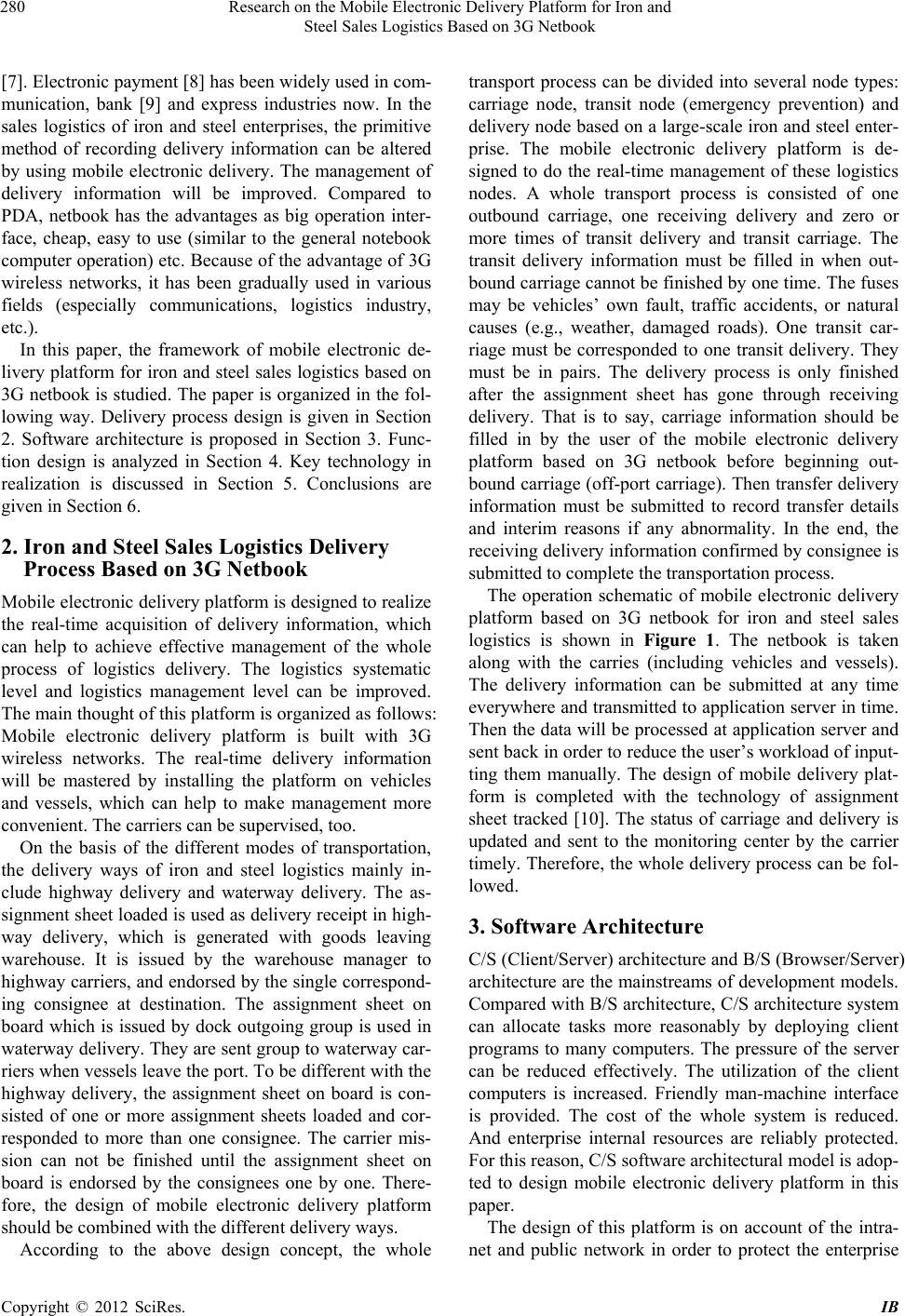
Research on the Mobile Electronic Delivery Platform for Iron and
Steel Sales Logistics Based on 3G Netbook
280
[7]. Electronic payment [8] has been widely used in com-
munication, bank [9] and express industries now. In the
sales logistics of iron and steel enterprises, the primitive
method of recording delivery information can be altered
by using mobile electronic delivery. The management of
delivery information will be improved. Compared to
PDA, netbook has the advantages as big operation inter-
face, cheap, easy to use (similar to the general notebook
computer operation) etc. Because of the advantage of 3G
wireless networks, it has been gradually used in various
fields (especially communications, logistics industry,
etc.).
In this paper, the framework of mobile electronic de-
livery platform for iron and steel sales logistics based on
3G netbook is studied. The paper is organized in the fol-
lowing way. Delivery process design is given in Section
2. Software architecture is proposed in Section 3. Func-
tion design is analyzed in Section 4. Key technology in
realization is discussed in Section 5. Conclusions are
given in Section 6.
2. Iron and Steel Sales Logistics Delivery
Process Based on 3G Netbook
Mobile electronic delivery platform is designed to realize
the real-time acquisition of delivery information, which
can help to achieve effective management of the whole
process of logistics delivery. The logistics systematic
level and logistics management level can be improved.
The main thought of this platform is organized as follows:
Mobile electronic delivery platform is built with 3G
wireless networks. The real-time delivery information
will be mastered by installing the platform on vehicles
and vessels, which can help to make management more
convenient. The carriers can be supervised, too.
On the basis of the different modes of transportation,
the delivery ways of iron and steel logistics mainly in-
clude highway delivery and waterway delivery. The as-
signment sheet loaded is used as delivery receipt in high-
way delivery, which is generated with goods leaving
warehouse. It is issued by the warehouse manager to
highwa y carriers, and endorsed by the sing le correspond -
ing consignee at destination. The assignment sheet on
board which is issued by dock outgoing group is used in
waterway delivery. They are sent group to waterway car-
riers when vessels leave the port. To be different with the
highway delivery, the assignment sheet on board is con-
sisted of one or more assignment sheets loaded and cor-
responded to more than one consignee. The carrier mis-
sion can not be finished until the assignment sheet on
board is endorsed by the consignees one by one. There-
fore, the design of mobile electronic delivery platform
should be combin ed with the different delivery ways.
According to the above design concept, the whole
transport process can be divided into several node types:
carriage node, transit node (emergency prevention) and
delivery node based on a large-scale iron and steel enter-
prise. The mobile electronic delivery platform is de-
signed to do the real-time management of these logistics
nodes. A whole transport process is consisted of one
outbound carriage, one receiving delivery and zero or
more times of transit delivery and transit carriage. The
transit delivery information must be filled in when out-
bound carriage cannot be finished by one time. The fuses
may be vehicles’ own fault, traffic accidents, or natural
causes (e.g., weather, damaged roads). One transit car-
riage must be corresponded to one transit delivery. They
must be in pairs. The delivery process is only finished
after the assignment sheet has gone through receiving
delivery. That is to say, carriage information should be
filled in by the user of the mobile electronic delivery
platform based on 3G netbook before beginning out-
bound carriage (off-port carriage). Then tran sfer deliv ery
information must be submitted to record transfer details
and interim reasons if any abnormality. In the end, the
receiving delivery information confirmed by consignee is
submitted to complete the transportation process.
The operation schematic of mobile electronic delivery
platform based on 3G netbook for iron and steel sales
logistics is shown in Figure 1. The netbook is taken
along with the carries (including vehicles and vessels).
The delivery information can be submitted at any time
everywhere and transmitted to application serv er in time.
Then the data will be processed at application server and
sent back in order to reduce the user’s workload of input-
ting them manually. The design of mobile delivery plat-
form is completed with the technology of assignment
sheet tracked [10]. The status of carriage and delivery is
updated and sent to the monitoring center by the carrier
timely. Therefore, the who le delivery process can be fol-
lowed.
3. Software Architecture
C/S (Client/Server) architecture and B/S (Browser/Server)
architecture are the mainstreams of development models.
Compared with B/S architecture, C/S architecture system
can allocate tasks more reasonably by deploying client
programs to many computers. The pressure of the server
can be reduced effectively. The utilization of the client
computers is increased. Friendly man-machine interface
is provided. The cost of the whole system is reduced.
And enterprise internal resources are reliably protected.
For this reason, C/S software architectural model is adop-
ted to design mobile electronic delivery platform in this
paper.
The design of this platform is on account of the intra-
net and public network in order to protect the enterprise
Copyright © 2012 SciRes. IB